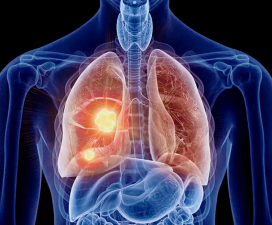What Are the Early Signs of Lung Cancer Most People Miss?
Lung cancer is a very common malignant tumor that is difficult to detect in its early stages. Once symptoms appear, it can cause serious harm to human health. The lungs are important respiratory organs, and maintaining good lung function is crucial for timely oxygen supply and normal life activities. Severe lung disease can affect the lungs' normal physiological functions. Therefore, if you notice lung cancer, you must take it seriously and take appropriate treatment. Many people say that lung cancer is silent in its early stages and is often detected in the middle or late stages. Is this true?
Lung cancer is a very common malignant tumor that is difficult to detect in its early stages. Once symptoms appear, it can cause serious harm to human health. The lungs are important respiratory organs, and maintaining good lung function is crucial for timely oxygen supply and normal life activities. Severe lung disease can affect the lungs' normal physiological functions. Therefore, if you notice lung cancer, you must take it seriously and take appropriate treatment. Many people say that lung cancer is silent in its early stages and is often detected in the middle or late stages. Is this true?

The following are common early signs of lung cancer:
- Chronic Cough
Cough is one of the most common early symptoms of lung cancer. If a cough persists for more than three weeks and does not improve significantly after standard cough suppressant treatment, it is a serious concern for lung cancer. This cough is usually dry and irritating, with no or only a small amount of white mucus. As the disease progresses, the cough may worsen, and symptoms such as blood in the sputum or hemoptysis may occur. This is because the tumor irritates the bronchial mucosa or invades the bronchial blood vessels, causing bleeding.
- Finger Clubbing
Finger Clubbing is a characteristic symptom of lung cancer, where the fingertips become enlarged, resembling drumsticks. The scientific explanation is generally that lung disease causes chronic hypoxia and metabolic disorders in the extremities, leading to tissue proliferation. Clubbing often indicates that lung disease has been present for some time and may be severe.
- Itchy Legs
Many people may not realize that itchy legs may also be related to lung cancer. Secretions from lung cancer cells enter the bloodstream and stimulate sensory nerve endings in the skin, causing itching. This itching is usually accompanied by a simple itch without obvious skin changes such as rashes or erythema, and is not effectively treated with conventional antipruritic medications. If unexplained, persistent itching occurs on the legs, after ruling out underlying skin diseases, lung cancer should be considered and prompt testing should be sought.
- Weight Loss
Significant weight loss in a short period of time, such as a weight loss of more than 5% in a month, without intentional dieting or increased exercise, should be a cause for concern. Lung cancer cells consume a large amount of nutrients during their growth, and the tumor can also affect the patient's appetite, leading to decreased food intake. In addition, lung cancer patients produce certain cytokines, which affect the body's metabolic function, causing it to enter a catabolic state and accelerate the loss of fat and muscle, leading to weight loss.
- Recurrent respiratory infections
Lung cancer attacks the body's immune system, weakening it. Consequently, some lung cancer patients may experience recurrent respiratory infections, such as pneumonia or bronchitis, in the early stages of the disease. This is due to the tumor compressing or blocking the airways, which impairs the immune system.

Who should be particularly vigilant?
- Long-term smokers
People who smoke a pack a day for more than 10 years have a significantly increased risk, and even after quitting, the risk persists for more than 15 years.
- People with a family history of lung cancer
Having a direct relative with lung cancer increases one's own risk by 2-3 times, which is closely related to genetic susceptibility.
- People who are exposed to cooking fumes
Chinese cooking fumes contain carcinogens such as benzopyrene. Among non-smoking female lung cancer patients, 35% are attributed to cooking fumes. 4. Occupationally Exposed Populations
People exposed to asbestos, arsenic, chromium, and other substances should begin screening earlier than the general population, even if they meet protective measures.









